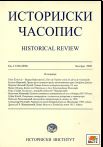Прилог познавању најстарије археометалургије српске средњовековне државе
Contribution to Understanding the Oldest Archaeometallurgy of Medieval Serbia
Author(s): Dušan MrkobradSubject(s): History
Published by: Istorijski institut, Beograd
Keywords: Serbia; Brskovo; king Stephen Radoslav; Saxons; mining; trade; coin mining; caravan roads
Summary/Abstract: In Serbian medieval archaeology the archaeometallurgy is entirely new field of investigation without tradition in our science. In the process of reconstruction of the old mines with traces of medieval mining the technical surveys have been undertaken very rarely and there were almost no archaeological investigations of these sites. Thus, the unique opportunity to reconstruct, at least partially, some of the mines in medieval Serbia has been missed. The remains of the mining installations, tools, equipment etc. have been collected only sporadically thanks to the enthusiasts in the profession. Very rich deposits in Serbia, known already from antique period and abandoned for some time, became suddenly interesting in the first half of the 13 th century. The decisive reason for this turn in mining and entire economic development of the medieval Serbian state is the arrival of the Saxon miners and smelters, certainly before 1254 when they are first mentioned in connection with the Brskovo mine. They brought new mining technology, introduced the work organization and qualified workforce to work in mines and smelteries and they also introduced their mining laws. I would like to point out the archaeological data which may, perhaps, complete picture concerning the beginning of the ores exploitation in Brskovo. In the course of systematic archaeological investigation 25 scyphates of king Radoslav have been found in the latest archaeological layers at the site RasPazarište near Novi Pazar. On the 17 specimens found at the same spot only the obverse had been struck and that was obviously the minting trail. From the same layer, also, some 20 small metal plates ready for striking coins and two copper ingots were found. The spectrometric analysis of the metal revealed that all these coin pieces and plates were made of an identical alloy consisting of copper with small admixtures of silver, lead and zinc. On the basis of such alloy composition it has been established with certainty that metal of which the first Serbian coins had been minted comes from Brskovo mining zone. And finally to conclude: it is possible to obtain more information about Brskovo only by future multidisciplinary investigations of the entire complex. It is the only way to trace data on the earliest medieval fortifications, miners’ settlements and necropolis, ore exploitation and processing, as well as the earliest material evidence for the craftsmanship, commerce and business relations of Serbia with the mining contractors from coastal towns.
Journal: Историјски часопис
- Issue Year: 2013
- Issue No: 62
- Page Range: 405-421
- Page Count: 17
- Language: Serbian

